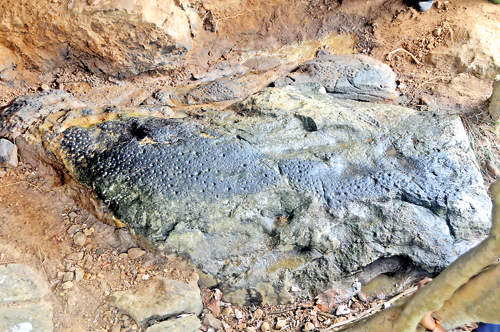Badahena-galge reveals prehistoric ‘language of dimples’
The cave called Badahena-galge is the ideal haunt for a leopard or sloth bear or giving occasional shelter for the villager foraging for the natural bounty of the thick forest. Till February this year, however, it was just one of the small caves that clung like swallows’ nests to the mountains of Balangoda. Till a team of academics discovered, on the cave floor, probably the largest graphic representation ever found in South Asia- telling the tantalizing tale of how Prehistoric Man used symbols for communication- at a time when scripts even of the crudest sort were still millennia in the future to appear.

The dimple pits: A form of communication?
The cave today is part of the village called Pinnagala- a village of farmers- part of the Sabaragamuwa province which always yielded much rich treasure to the archaeologist. In a roll call that runs from the Balangoda Man to extinct rhinoceros and hippopotami and lion fossils, Badahena-galge is the latest. The wet lush fecundity of the area meant it was always rich in biodiversity, and early man found enough plant material here as well as small game as food.
Many caves around this galge are known haunts of early prehistoric man. Micro blades made of quartz and pecked water-worn pebbles (‘quartzite’) used as soft-hammers have been found there.
Mid- February this year saw the arrival here of Prof. Raj Somadeva and his team from the Postgraduate Institute of Archaeology (PGIAR) of the University of Kelaniya.
The ‘graphic representation’ they found like an antediluvian tapestry is actually made of small ‘cupules’ or ‘dimple pits’- as the archaeologists term them so astutely. Looking like pimple holes on the rock, they would have no significance to the lay person and little meaning even for the antiquarian at first.

Prof. Raj Somadeva
The nearly 1000 small pits stretch for some 4 square metres on this rock.
The first task for the archaeologists was to ascertain that these were man-made and not of natural formation- a bona fide symbolic ‘language of dimples’.
They cannot be the result of mere weathering- because the marks appear only on a limited surface. Also, at the most cursory glance, you could see that the pits have different surface diameters. Using a digital caliper they were measured, and it was discovered that the majority were between 9 and 10 centimetres. There were however bigger ‘outlier’ pits- including one that had a diameter of 24 centimetres- which must ‘signify some sort of an emphasis’- according to Prof. Somadeva. Patterns like these indicate a fixed form of communication.
And then there are other formations of the rock that have been carved by human hand- such as one linear depression which- if not gouged by man’s artifice- could only have been made by a continuous flow of water, and there has been no such water in the cave at any time.
The natural deduction left is that the linear depression and other deformations on the rock are man-made, and ergo- the dimple pits and the rock with all its deformations are one, single communicative fabric.
This is not the first instance, nevertheless, when graphic representations have been discovered in Sri Lanka. The late P. E. P. Deraniyagala observed small scale rocks, bearing such pit markings, in Bellanbendipelessa, also near Balangoda. However, he explained them away quite differently.
The small dimple pits- Deraniyagala thought- were “anvils for flaking quartz, cracking nuts and extracting poisons for use on blow pipe darts” while “the large ovate hollows… had served as grindstones for pigments and perhaps grain”.
But Prof. Somadeva points out that, even if at least in the instance of Badahena-galge, this cannot be the explanation. He points out that the dimple pits are at the edge of the cave and not “the summit of the rock- which is spacious and easily accessible” for practical operations like cracking nuts, flaking stones and extracting poisons.
The final conclusion that the team arrived at was that this was a human action, not for functional use as Deraniyagala thought- but to communicate. The arrangement, the volume and the internal variations pinpoint that the cave dwellers were perpetuating and expressing a firm idea or a set of ideas significant to the prehistoric communities.
But exactly what kind of threat, invocation, mantra, poem, primitive fable or saga did our hirsute ancestor etch so fondlyby his hearth for us to muse over? “It’s very dangerous to guess,” cautions Prof. Somadeva with academic prudence, adding that they are waiting for the findings to be dated.



